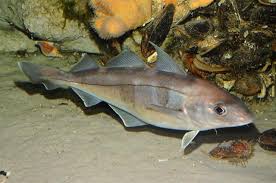Haddock (Melanogrammus aeglefinusIt is an important industrial fish species that lives in the cold waters of the North Atlantic. It is known for its delicious white meathigh nutritional value and important in the fishing industry.
🔹 What makes haddock special?
✔ Popular commercial fish - occupies an important place in the North Atlantic fisheries
✔ A valuable source of protein - rich in trace elements and Omega-3 fatty acids
✔ Great taste - soft, tender white meat
✔ It is distinguished by a characteristic dark spot behind the pectoral fin
Despite its commercial value, overfishing threatens haddock populationsthis requires strict fisheries control and environmental measures.

Scientific classification
🔬 Haddock taxonomy:
✔ The Kingdom: Animals (Animalia)
✔ Type: Chordal (Chordata)
✔ Class: Lucheperi pisces (Actinopterygii)
✔ Row: Cod-shaped (Gadiformes)
✔ Family: Cod (Gadidae)
✔ Gender: Melanogrammus
✔ View: Melanogrammus aeglefinus
📌 Interesting!
Have a haddock a close relative of cod (Gadus morhua), but it is easily distinguished by a black spot on the side.
Description and anatomy
🔹 Main features of haddock:
✔ Length: as usual 30-70 cm, but it can reach 1.1 m
✔ Weight: on average 1.5-3 kg, record individuals weigh up to 19 kg
✔ Life span: to 15 years, but usually 6-10 years old
✔ Sea dweller - lives in the depths from 40 to 300 m
🔹 Appearance features:
✅ Elongated, fusiform body
✅ Silver-gray color scheme with a purple or blue tint
✅ Dark Side Line and a distinctive black spot behind the pectoral fin
✅ Three dorsal and two anal fins
✅ Moustache on the chin - help you feel food on the bottom
📌 Interesting!
A dark spot on the body of haddock, according to legend, is St. peter's fingerprint.
Range and habitat
🌍 Where does haddock live?
✅ North Atlantic:
* Off the coast Europe (Norway, Iceland, United Kingdom)
* On the East coast North America (Canada, USA)
✅ Main fishing areas:
* North Sea
* Norwegian Sea
* Barents Sea
* Greenland waters
🔹 Living environment:
✔ It lives at depths of 40-300 m., but sometimes occurs at 450-500 m
✔ Likes muddy and sandy bottom
✔ Prefers cold water (4-10°C)
✔ It is often found in large flocks
📌 Interesting!
Haddock avoids fresh water but it keeps only in the sea zone.

Lifestyle and behavior
🔹 Behavior features:
✅ It lives in large flocks "it protects her from predators
✅ Migrates over long distances in search of food and spawning grounds
✅ Able to navigate in the water with the help of a side line
📌 Interesting!
Unlike cod, haddock more thermophilic and it does not descend to great depths in cold seasons.
Food and hunting
🔹 What does haddock eat?
✅ Crustaceans (krill, shrimp, crab)
✅ Shellfish (mussels, shell organisms)
✅ Young fish and larvae (herring, capelin)
✅ Worms and plankton
📌 Interesting!
Haddock has sensitive moustachewhich help it find food on the sea floor.
Reproduction and life cycle
🔹 Features of spawning:
✔ Sexual maturity reaches in 2-5 years
✔ Spawning occurs in spring (March-June)
✔ Females lay up to 3 million eggs
✔ Larvae develop in the upper layers of water, and then sink to the bottom
📌 Interesting!
Haddock eggs they swim in the water column and they are carried by currents for hundreds of kilometers.

Haddock and the man
🔹 Importance in industry:
✅ Popular fish in cooking - used for cooking fillets, smoking, drying
✅ One of the main fish species used for fish and chips in the UK
✅ High nutritional value - rich in protein, vitamins B12, D and Omega-3
🔹 Threats to the public:
❌ Overfishing
❌ Industrial ocean pollution
❌ Water temperature changes due to global warming
⚠ Population status:
* Overall population remains stable, but needs to be monitored in some regions
* Entered data catch quotas in Europe and North America
📌 Interesting!
Haddock is often confused with cod, but it has brighter taste and more delicate texture of meat.
Conclusion
🌊 Haddock is not only a valuable industrial species, but also an important element of marine ecosystems.
🥇 Its tender meat and nutritional value make it popular all over the world.
⚠ However, overfishing can lead to population declines, so environmental controls are necessary.
🍽 Have you ever tried haddock dishes? How do you like the taste of it? 😋🐟